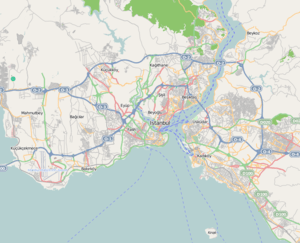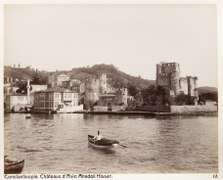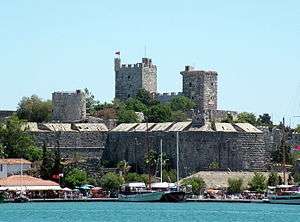Anadoluhisarı
Anadoluhisarı (English: Anatolian Castle), known historically as Güzelce Hisar ("the Beauteous Castle"[1]) is a medieval fortress located in Istanbul, Turkey on the Anatolian (Asian) side of the Bosporus. The complex is the oldest surviving Turkish architectural structure built in Istanbul, and further gives its name to the neighborhood around it in the city's Beykoz district.
| Anadoluhisarı | |
|---|---|
| Anadoluhisarı, Istanbul, Turkey | |
 | |
 Anadoluhisarı | |
| Coordinates | 41.081944°N 29.066944°E |
| Type | Fortress |
| Site history | |
| Built | 1394 |
| Built by | Bayezid I |
History
Anadoluhisarı was built between 1393 and 1394 on the commission of the Ottoman Sultan Bayezid I, as part of his preparations for a siege on the then-Byzantine city of Constantinople, the naval blockade of which took place in 1395 under Bayezid's orders.
Constructed on an area of 7,000 square metres (1.7 acres), the fortress is situated at the narrowmost point of the Bosporus, where the strait is a mere 660 meters (2,170 ft) wide. The site is bound by Göksu (Ancient Greek: Aretòs) creek to the south, and was previously home to the ruins of a Roman temple dedicated to Uranus.[2] Erected primarily as a watch fort, the citadel has a 25 meters (82 ft) tall, quadratic main tower within the walls of an irregular pentagon, with five watchtowers at the corners.
After Bayezid's campaign was first interrupted by the Crusade of Nicopolis, and then the Battle of Ankara, an 11-year period of turmoil took hold of the Ottomans, which ended with the ascent of Mehmed I to the throne. His grandson, Sultan Mehmed II reinforced the fortress with a two-meter-thick wall and three additional watchtowers, and added further extensions, including a warehouse and living quarters. As part of his plans to launch a renewed military campaign to conquer Constantinople, Mehmed II further built a sister structure to Anadoluhisarı across the Bosphorus called Rumelihisarı, and the two fortresses worked in tandem in 1453 to throttle all maritime traffic along the Bosphorus, thus helping the Ottomans achieve their goal of making the city of Constantinople (later renamed Istanbul) their new imperial capital.
After the Ottoman conquest of the city, Anadoluhisarı served as a customs house and military prison, and after several centuries, fell into disrepair.
After the fall of the Ottomans and the 1923 establishment of the Republic of Turkey, the newly-created Turkish Ministry of Culture tended to and ultimately restored the site in 1991 - 1993. Today, Anadoluhisarı lends a picturesque appearance to its corner of the Bosphorus alongside the timber yalı homes that define the neighborhood, and functions as a historical site, although it is not open to the public.
- Anadoluhisarı as seen from the local quay.
_IMG_7775_1920.jpg) Anadoluhisarı amidst the traditional Istanbul waterside mansions known as yalı.
Anadoluhisarı amidst the traditional Istanbul waterside mansions known as yalı.- Local street view of the neighborhood of the same name.
- View of the neighborhood quay.
 Anadoluhisarı from a postcard dated 1901.
Anadoluhisarı from a postcard dated 1901.
Notes
- Finkel, Caroline (2006). Osman's Dream: The History of the Ottoman Empire 1300-1923. New York: Basic Books. p. 24. ISBN 978-0-465-02397-4.
- Ahmet Muhtar Paşa (1902). Feth-i Celil-i Konstantiniye. Bedir Press. p. 21.
External links
References
| Wikimedia Commons has media related to Anadolu Hisarı. |

